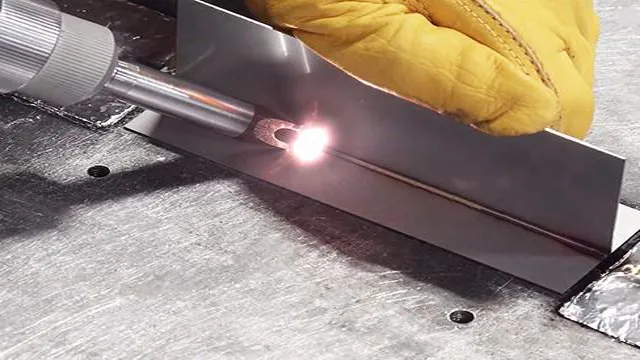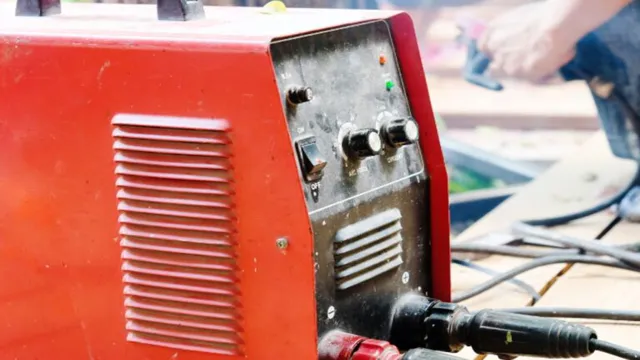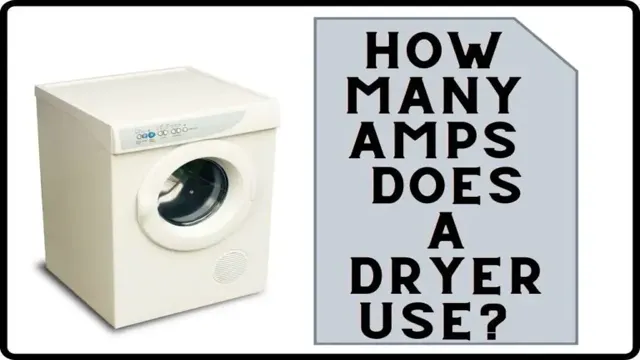How to Check Voltage on Welding Machine: A Beginner’s Guide to Testing Voltage Levels

Are you a welder or planning to learn welding as a new skill? Checking the voltage of your welding machine is crucial for a successful welding project. It helps you determine if your machine is functioning correctly and if it’s safe to use. However, if you’re new to welding, you might be wondering where to start.
Don’t worry; we’ve got you covered. In this blog post, we’ll be discussing how to check the voltage on a welding machine. Think of it as checking your car’s oil level before a long drive – a necessary step for a smooth ride.
So, let’s get started and ensure you’re ready to tackle any welding project that comes your way!
Understanding the Importance of Checking Voltage
When it comes to welding machines, checking the voltage is crucial to ensuring a safe and effective welding process. But how exactly do you go about checking the voltage on your machine? First, make sure the machine is turned off and unplugged. Then, locate the voltage selector switch, which is typically located near the power input.
Use a multimeter to test the voltage by placing the positive probe on the positive terminal of the machine and the negative probe on the negative terminal. The multimeter should read the voltage level, which can vary depending on the specific welding machine. It’s important to check the voltage before every use, as fluctuations can occur that can affect the quality of the weld and even pose a safety hazard to the operator.
By regularly checking the voltage on your welding machine, you can ensure a smooth and safe welding experience every time.
Why is it Important to Check Voltage on a Welding Machine?
As a welder, it’s crucial to check the voltage on your welding machine. Voltage is the measure of electrical pressure, and it determines the heat generated by the welding machine. Understanding this is vital because if the voltage is too high, it can damage the material you’re welding and potentially put you and others at risk.
On the other hand, if the voltage is too low, it won’t melt the metal entirely, resulting in weak welds. Checking the voltage before use helps ensure that you’re operating the welding machine at the optimal power level for the specific job. Ultimately, checking the voltage on your welding machine is an essential step to ensure the quality and safety of your welding work.

Potential Hazards of Ignoring Voltage Levels
Ignoring voltage levels can lead to potential hazards that can endanger both people and equipment. It is crucial to understand the importance of checking voltage to prevent any unwanted incidents. Overloading the circuits, faulty wirings, and power surges are some of the factors that can cause voltage fluctuations.
These fluctuations can cause serious damage to appliances and may also lead to electrical fires. Voltage checks should be included in regular maintenance checks, especially in high-demand areas such as factories, hospitals, and commercial buildings. Just like checking the oil in a car engine, voltage checks can indicate potential problems and prevent costly repairs in the future.
It’s always better to be safe than sorry, so always make sure to prioritize safety by checking voltage levels regularly and fixing any issues immediately.
Tools Needed to Check Voltage on a Welding Machine
If you’re a welding enthusiast or a professional welder, you know how crucial it is to check voltage on a welding machine before starting your welding projects. To do this, you’ll need a few tools – a voltmeter, preferably a digital one, and a pair of safety gloves for protection against electrical shock. Firstly, make sure the welding machine is switched off and unplugged from the power source.
Then, using your safety gloves, connect the voltmeter probes to the welding machine terminals according to the manufacturer’s manual, and switch on the machine. The voltmeter will display the welding machine’s voltage, which should match the machine’s specifications. If the voltage reading is not accurate, you may need to calibrate your welding machine or consult a professional welder.
Checking the voltage on your welding machine ensures that you get reliable and consistent welds, and also protects yourself and others from potential electrical hazards.
List of Required Tools
If you’re planning to check the voltage on a welding machine, it’s important to have the right tools for the job. Firstly, you’ll need a multimeter, which is an electronic device that measures voltage, current, and resistance in an electrical circuit. Make sure to select a multimeter with a voltage range that’s appropriate for your welding machine.
Additionally, you’ll require a set of test leads or probes to connect the multimeter to the machine. It’s crucial to check that the leads are rated for the voltage you’ll be measuring. Another essential tool is a grounding clamp, which is attached to the welding machine ground to ensure a safe working environment.
Lastly, you may want to consider a high-temperature probe to take measurements in high-heat environments. With these tools by your side, you will be ready to safely and accurately check the voltage on your welding machine.
Checking the Voltage on a Welding Machine
If you’re a welder, it’s important to know how to check the voltage on your welding machine. First, make sure the machine is turned off and unplugged. Then, locate the voltage control knob on the machine.
Turn it to the lowest setting. Use a multimeter to test the voltage. Set the multimeter to DC voltage and touch the red lead to the positive terminal on the machine and the black lead to the negative terminal.
The voltage reading should match the setting on the control knob. If it doesn’t, you may need to adjust the knob or have the machine serviced. Checking the voltage on your welding machine is an important step in ensuring your safety and the quality of your work.
By following these simple steps, you can ensure your machine is functioning properly and avoid any potential hazards.
Step-by-Step Guide on Checking Voltage Operation
Checking the voltage operation is an essential step in maintaining and securing welding machine operation. As a welder, you must verify the voltage regularly to ensure its safety and proper performance while welding. To accomplish this, you first need to understand how to check the voltage.
Begin by reading the manual and locating the welding machine’s voltage output, which is usually found near the power source. Then using a voltmeter set on AC or DC voltage, clamp it onto the positive and negative output terminals of the welder. This will enable you to measure the voltage produced by the machine.
The voltage reading should match the voltage measurements required to complete the welding task correctly. In summary, confirming the voltage output of a welding machine is an essential step in securing proper performance and safety. By using a voltmeter and following the manufacturer’s instructions, you can accurately measure the voltage output and increase your confidence in the welding process.
Remember, it is best practice to check the voltage operation on a routine basis to avoid unwarranted setbacks and possible damage.
Preparation Before Checking Voltage
Before checking the voltage on your welding machine, it’s essential to take some basic safety precautions to prevent any accidents. First of all, you should make sure that your machine is disconnected from the power source to avoid getting shocked. You should also wear protective gear, such as gloves and goggles, to protect your hands and eyes from any potential hazards.
Additionally, you should inspect the machine for any signs of damage or wear and tear before turning it on. Once you’ve taken these steps, you can proceed to check the voltage on your welding machine. Start by turning on the machine and selecting the appropriate settings for your project.
Then, use a multimeter to check the voltage by testing the terminals on the machine. With these precautions taken, you can rest assured that you’re working safely and efficiently on your welding projects. Remember, safety first!
Steps on How to Check Voltage
If you’re not getting the results you want from your welding machine, it might be time to check the voltage. Luckily, checking the voltage on a welding machine is a relatively simple process. First, you’ll need to locate the voltage dial on your machine.
This can typically be found on the front panel or in the owner’s manual. Once you’ve located the dial, switch on your machine and set it to the highest voltage setting. Next, use a multimeter to check the voltage output.
Place one of the probes on the positive terminal and the other on the negative terminal. You should see a reading of around 20 volts, depending on your machine. If the reading is significantly higher or lower than this, you may need to adjust the voltage dial or seek professional help.
With these steps, you can ensure that your welding machine is operating at the correct voltage for optimal performance.
Final Thoughts
In conclusion, checking the voltage on your welding machine is a crucial step to ensure the safety of yourself and others around you. With the proper tools and knowledge, as we’ve detailed in this article, you can accurately measure and read the voltage output of your machine. This can prevent potential accidents and ensure the quality of your welding work.
Remember to always check the specifications of your individual machine and follow the manufacturer’s instructions for your specific model. By properly maintaining and monitoring your welding machine, you can ensure a safer and more efficient welding experience.
Conclusion
So, to summarize the steps of checking voltage on a welding machine: find a suitable voltage tester, attach it to the electrode holder or work clamp, and read the display to ensure the voltage is within the recommended range. It may seem like a shocking process (pun intended), but it’s crucial to ensure safe and effective welding results. Remember, if you’re not getting the voltage you need, it’s time to amp things up.
Happy welding!”
FAQs
What equipment do I need to check the voltage on my welding machine?
To check the voltage on your welding machine, you will need a voltmeter and a set of probes.
Can I check the voltage on my welding machine without a voltmeter?
No, a voltmeter is necessary to accurately measure the voltage on your welding machine.
How do I attach the probes to my welding machine to check the voltage?
To check the voltage on your welding machine, attach the probes from the voltmeter to the positive and negative terminals on the machine.
What should the voltage reading be on my welding machine?
The voltage reading on your welding machine may vary depending on the type of machine and the setting you have it on. Consult your machine’s manual for specific voltage requirements.
Why is it important to check the voltage on my welding machine?
Checking the voltage on your welding machine ensures that it is operating properly and at the correct level to produce quality welds.
How often should I check the voltage on my welding machine?
It is recommended to check the voltage on your welding machine before each use to ensure it is functioning properly.
What should I do if the voltage on my welding machine is not at the correct level?
If the voltage on your welding machine is not at the correct level, consult your machine’s manual for troubleshooting tips or contact a professional for assistance.








